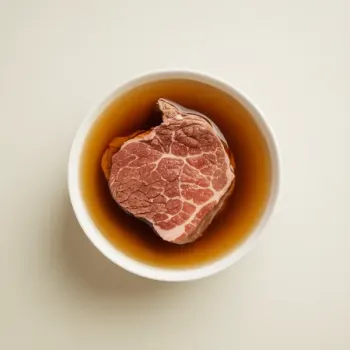Dashi Stock and Beef Broth are cooking liquids that enhance flavors in dishes. Dashi is a light, umami-rich Japanese broth, while Beef Broth is a hearty, meaty Western base used in soups, stews, and sauces. They differ in taste, preparation, and culinary applications.

Dashi Stock is a delicate yet umami-packed Japanese broth made from ingredients like kombu (dried kelp), bonito flakes (dried smoked tuna), or shiitake mushrooms. It's the backbone of many Japanese dishes and brings a distinct savory note to the table.

Beef Broth is a rich and hearty liquid made by simmering beef bones, meat scraps, and vegetables. Often used in Western cooking, it imparts a deep meaty flavor and is a staple in soups, stews, and sauces.
The primary difference lies in their flavor profiles and preparation. Dashi has a light, clean taste with a strong umami punch, while Beef Broth offers a robust, meaty flavor. Dashi is typically clearer and simpler to prepare, whereas Beef Broth can take hours to develop its richness. In terms of origin, Dashi is a cornerstone of Japanese cuisine, while Beef Broth is a Western favorite.

Your ultimate Recipe Box, Meal Planner, and Cooking Class all in one
Dashi is best used in soups like Miso Soup, Clear Broth Soups, and noodle dishes such as Udon or Soba. It provides a subtle complexity without overpowering other ingredients. Tip: Add Dashi at the end of cooking to preserve its delicate flavor. Beef Broth shines in hearty Western soups like Beef Barley Soup, Minestrone, or French Onion Soup. It creates a rich base that can stand up to longer cooking times. Tip: Roast bones before simmering to deepen the broth's flavor.
While not commonly used in stews, Dashi can be used for light vegetable or tofu stews where a subtle taste is desired. It's also great for gently simmering fish or chicken. Tip: Keep the simmering gentle to avoid bitterness. Beef Broth is ideal for robust stews and braises like Beef Stew, Pot Roast, or Osso Buco. Its full-bodied nature tenderizes meats and enriches the dish's overall flavor. Tip: Deglaze your pan with a bit of broth to incorporate all the tasty bits into your stew.
Dashi serves as a subtle base for Japanese sauces like Ponzu or a glaze for dishes like Teriyaki. It adds umami without overwhelming other flavors. Tip: Use Dashi to thin out sauces while boosting their savory notes. Beef Broth is excellent for making reduction sauces, gravies, and glazes that accompany red meats. It lends a rich, velvety texture and a complex taste. Tip: Reduce the broth slowly to concentrate the flavors for a luxurious sauce.
Dashi Stock is generally lower in calories and fat compared to Beef Broth, making it a lighter option. However, Beef Broth may offer more protein and a richer nutrient profile from the simmered bones and meat.
| Nutrient | Beef Broth ( per Cup ) | Dashi Stock ( per Cup ) |
|---|---|---|
| Fat | 0.5g | 0g |
| Sodium | 860mg | 1000mg |
| Calcium | 15mg | 10mg |
| Protein | 3g | 1g |
| Calories | 15 | 10 |
| Carbohydrates | 1g | 1g |
Yes, if you use a kombu or shiitake-based Dashi, it can be a great vegetarian substitute for Beef Broth.
Dashi Stock is lighter in calories and fat, but 'healthier' is subjective and depends on your dietary needs and preferences.
Beef Broth won't have the same kind of umami as Dashi, but adding ingredients like mushrooms can enhance its umami quality.
No, there are vegetarian versions of Dashi Stock made with kombu or shiitake mushrooms.
Both can be stored in the refrigerator for up to a few days or frozen for longer storage, typically up to 3 months.